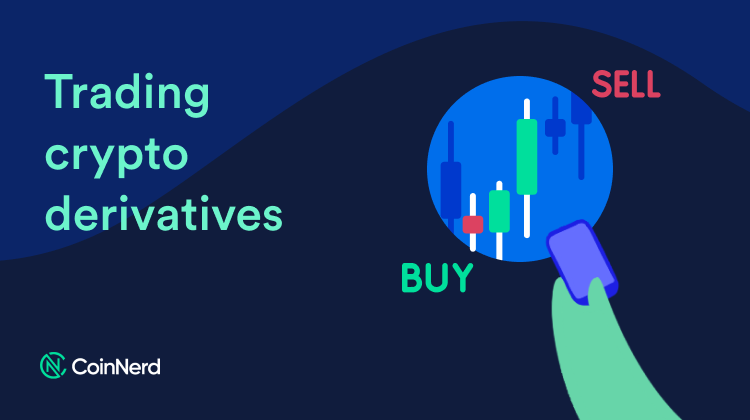Crypto Derivatives 101: A Beginner’s Guide on Crypto Futures, Crypto Options and Perpetual Contracts
The Crypto market has continued to soar higher and higher year after year. While many analysts predict that Bitcoin will fall and crash to zero, the asset has continued to skyrocket. Since the day it was launched, Bitcoin has risen by over 9,000,000%, a phenomenal growth that has never been seen anywhere in any other industry globally.
With the maturity of the crypto industry, crypto trading has become a major lucrative business that gives traders profits daily. One of the newest additions to the crypto trading industry is crypto derivatives. This article will discuss further crypto derivatives and crypto options and show you how you can trade them to get maximum profit.
What Are Crypto Derivatives
A Derivative is a financial product or contract whose value is dictated by an underlying asset. Derivatives can be based on currencies, exchange rates, interest rates, commodities, stocks, and even cryptocurrencies.

The traders of such contracts make predictions on the price of the underlying asset. In essence, they earn profits by wagering on the future value of the underlying assets. In cryptocurrency, the underlying assets of the derivatives are cryptocurrency tokens of different companies. Examples of such tokens include Synthetix, Bitcoin, Ethereum, UMA, DYDX, and others.
In crypto derivatives, two parties enter into a financial contract where they speculate on the asset’s future price. Investors can profit from changes in the price of the underlying asset by purchasing the cryptocurrency derivative at a lower price. They can sell it at a higher price later to net a profit.
Intrinsic Vs Extrinsic Value in Derivatives
Depending on the type of derivatives you are trading, they will typically have intrinsic or extrinsic value. The intrinsic value of a derivative is determined by the value of the underlying asset. For example, if you are trading bitcoin derivatives, the value of Bitcoin will determine the intrinsic value of that derivative.
There are certain derivatives like options that also have extrinsic value. Please note that options and futures have an expiry date. So, if you were to buy a Bitcoin option, for example, there will be a date on which the validity of that option contract expires. The closer the option gets to the expiration date, the more value it loses.
This is because there is a small window for any price changes to occur in the underlying asset. This is what determines the extrinsic value of the contract or derivative. If the expiration date is way ahead, it means that the value of the derivative has enough time to change significantly. As such, the derivative is said to have a bigger extrinsic value.
When trading crypto options, futures, and derivatives, you must always consider both the intrinsic value and the extrinsic value. For less risk, you can buy relatively nonvolatile crypto derivatives with a longer expiration date. But for the risk-takers who want to cash in big, volatile derivatives with shorter expiration windows are often ideal.
Types of Crypto Derivatives
There are many different types of derivatives in cryptocurrencies to choose from. Each of these instruments carries its own unique risk as well. Crypto derivatives can be one of the following instruments depending on the conditions dictated in the contract:
Futures
These are crypto derivatives that involve a legal agreement between two parties to buy or sell the underlying asset at a specified price and date in the future. The contract will only be directly executed when that date arrives. Such contracts are carried out on regulated exchanges.
Futures are very common in traditional financial and commodity markets. But they have also become very central in the way people trade cryptocurrencies in recent years. However, futures on crypto are only available in a few select exchanges.
Options
Traders who have an options contract are presented with the choice to buy or sell an underlying asset at a defined, dictated future, price, and date.
However, in contrast with a futures contract, a trader of an options contract is not bound to buy or sell the underlying asset at the date defined in the contract. So, in essence, the trader gets the right to buy an asset at a specific price and date, but not the obligation to do so.
Perpetual Futures
A perpetual is a futures contract in which there is no expiration or date of settlement. In some circumstances, traders can keep their position open without any definite closure date.
For such circumstances, the traders’ account must hold a certain amount of cryptocurrency to cover any losses. This helps to avoid the automatic liquidation of open positions by the volatile price movement of the cryptocurrency markets.
Swaps
A swap is a contract between two parties to exchange cash flows at a specified later date. In this exchange, the swap is specified by a predetermined formula. These are over-the-counter contracts (OTC), and they are not traded on exchanges.
Some of the features of derivatives trading, including swaps, are things like stop loss, take profit, partial close orders, and insurance. These features allow traders to escape liquidation and to manage their risk and exposure to the markets during volatile market times.
How Do Derivatives Work
The derivatives market does not deal with fungible assets. It is a secondary market in principle that is focused on the volatility of capital assets. Financial products that are traded in the derivatives market are all based on different underlying values.
As you know, the traditional crypto market is riddled with high volatility, which dictates high price fluctuation. The derivatives market is created as a hedge against this volatility. The derivatives market brings some level of stability to the most crucial global financial markets.
Additionally, the derivatives market itself offers tremendous wealth-generating opportunities. While the market is speculative at best, this speculation is what gives these derivative assets their value.
Also, the link between the derivative and its underlying asset gives them powerful credibility. Besides, most brokers allow you to trade crypto options and derivatives using leverage. This allows for larger participation by investors at extremely lower entry prices.
How to Trade Crypto Options
Trading crypto derivatives is easy if you understand how to move about in the blockchain ecosystem. But you also need some financial background. After all, crypto derivatives are tradable securities or contracts with foundations in traditional finance.
But there is some good news. Cryptos, futures, and options have now been added and are among the most common financial products on any major cryptocurrency exchange. There are in fact exchanges today that are fully dedicated to crypto futures options, and swaps.

While trading crypto derivatives has its advantages, it also has its limitations, which shall be discussed later in this article. However, taking advantage of the full power of the derivatives market, users can mitigate risks associated with high volatility and hedge against potential losses. To trade crypto derivatives, follow the steps below.
- Register a free account at a leading cryptocurrency exchange. For this article, we shall use Binance as an example. Register a free Binance account and click ‘open now’ to activate your trading account.
- Choose the contract you want to trade and adjust the position mode. This will allow you to select the hedging mode and set the leverage multiplier then transfer the asset into your futures account.
- Purchase crypto assets before you open a futures account since you need to transfer them from your spot account to your futures account. Binance offers several payment methods, including Fiat that can allow you to directly purchase cryptocurrencies and exchange them for the ones that are supported in crypto derivatives.
- After opening and depositing crypto assets in your futures account, you can open positions on the platform. Binance futures include order types like limit, market, and stop limit.
You can also monitor your position at the bottom of the screen to ensure that you are not stopped out when you are on profit. You can close your position to lock in your profits as well. These are the basics of trading crypto derivatives.
There might be slight differences depending on which platform you choose to trade. However, if you choose Binance, the steps are as listed above. Many other platforms offer crypto derivatives trading.
The Advantages and Disadvantages of Crypto Derivatives
Trading crypto derivatives is an extremely profitable venture. However, it has its limitations. Before you put your money into this industry, you ought to have a clear picture of what you are doing. Here are some tips:
Advantages of crypto derivatives
Cryptocurrency derivatives serve as risk mitigation for numerous traders. During price fluctuations, derivatives can protect traders from incurring huge losses. Additionally, crypto derivatives allow traders to access available assets or markets.
At the beginning of 2017, there were only spot exchanges for traders. However, as the market began to grow, futures were introduced. The majority of traders who have a lot of money prefer to trade using futures if they can make handsome incomes within a short time.
The derivatives market can also generate insights into the market movement. This is because the derivatives market is volatile and can hint where the underlying asset’s direction is likely to go. Also, the cryptocurrency derivatives provide the opportunity to try out more sophisticated trading strategies which can help traders net more profit.
Finally, crypto derivatives allow traders to gain access to the cryptocurrency markets without holding any cryptocurrency. This is a major selling point for many traders, especially those coming in from traditional finance. Derivatives allow them to trade cryptocurrencies without the need to buy or hold cryptocurrencies.
Limitations of Derivatives trading
The derivatives market also has some challenges and limitations. While the derivatives offer long-term risk mitigation, short-term price fluctuations can lead to significant losses. Think of it this way. Bitcoin has crashed more than 10 times in the past 10 years.
In each time, hundreds of thousands of traders lose millions of dollars. Hence, the allure of long-term risk mitigation is disqualified by the short-term risk of high price fluctuations that can wipe out accounts or leave them with significant losses.
Additionally, the derivatives markets offer intrinsically sophisticated contracts and make valuation extremely complicated. This means that it is extremely easy for new or traders who are not experienced with this market to make mistakes and make losses.
Finally, over-the-counter transactions do not always follow exchange rules, or trading regulations and compliance procedures. This can be too risky for traders.
Where to Trade Crypto Derivatives
Derivatives can be traded on traditional financial exchanges. However, since the crypto markets are very young and very volatile, the majority of traditional industries and finances have not embraced cryptocurrencies onto their platforms.
Therefore, to trade cryptocurrency derivatives, traders have to join cryptocurrency exchanges such as Binance, FTX, and KuCoin to access these markets. Derivatives in cryptocurrency can be traded on both centralized and decentralized exchanges.
It is also important to note that there are certain dedicated platforms designed for derivatives only. Crypto derivatives trading platform offers more flexible trading options apart from spots margin trading.

These markets give traders access to assets that would otherwise be inaccessible to regular traders. The advantage of using dedicated crypto derivatives trading platforms is that they offer low transaction fees and help in risk management. The exchanges also have numerous cryptocurrency derivatives from which traders can choose.
While the entire crypto market stands at around $1.9 trillion right now, the crypto derivatives market saw highs of up to $3 trillion in 2021. More than 60% of all crypto trading is done on crypto derivatives.
Top Crypto Derivatives Trading Platforms
Some of the top 10 Crypto derivatives exchanges globally include Binance, OKEx, Huobi, FTX, Bybit, Coin Flex, KuCoin, Gate.io, Deribit, and BitFinex. They are listed according to their popularity, the number of futures contracts that are offered, and such factors.
However, Binance is the leading cryptocurrency derivatives exchange in terms of the sheer volume of trade. But according to the number of perpetual futures contracts offered, Huobi is the leading exchange with 194 contracts. When you consider the maker and the taker’s fee. FTX is the most expensive cryptocurrency platform to trade on derivatives.
Trading Crypto Derivatives Using Leverage
Derivatives often involve the borrowing of large sums of money to magnify the bets on the financial assets being traded. This is what we call leverage or margin trading. But it is not always accessible everywhere.
In the United States, for example, crypto exchanges cannot offer leverage trading on crypto without being regulated by the SEC (Securities and exchanges commission). And since most of these exchanges are designed to avoid SEC scrutiny, it may be harder to get leveraged derivatives trading in the US. But in other countries, these products are available.
This is also why the Majority of crypto derivatives operate from offshore countries. Platforms like Binance, FTX, and OKEX are unregulated and therefore cannot open crypto derivatives in the United States. Only the CME Group is regulated to offer futures in the United States.
The CME Group accounted for 4% of all global crypto derivatives trading in the past year 2021. It also launched micro futures versions of Bitcoin and Ethereum crypto assets to appeal to smaller crypto investors.
The traditional futures industry can see a real opportunity in offering crypto derivatives. However, the laws surrounding securities and derivatives are murky and companies need to tread carefully to avoid investigation and prosecution by the SEC.
With leveraged futures and options, traders are allowed to put down only a fraction of the value they intend to trade. They then use multipliers to bet that prices will rise or fall to certain points over a given time.
Leveraged trading allows you to control a huge financial position using a small amount of money. A user or a trader can increase the size of the leverage to get more profits. However, the larger the leverage, the riskier the position.
Conclusion
Indeed, it is evident that cryptocurrency derivatives are some of the most rapidly growing financial instruments. The majority of traders want to get in on the action before the industry grows too big. The entire crypto market industry is about $ 1.9 trillion, which makes it relatively small compared to the global derivatives market.
It is estimated that cryptocurrency markets will grow even though we have seen challenges in recent months. Due to inflation in the traditional global economy, the cryptocurrency industry could offer a real alternative to traditional assets. The derivatives space in crypto will be at the center of all this. It is an industry that is truly worth watching for both beginner and seasoned traders.
* We hope this information will help you in your investment process, but this is not investment advice. Every investment carries risk, especially in this industry, so DYOR before making a decision.






